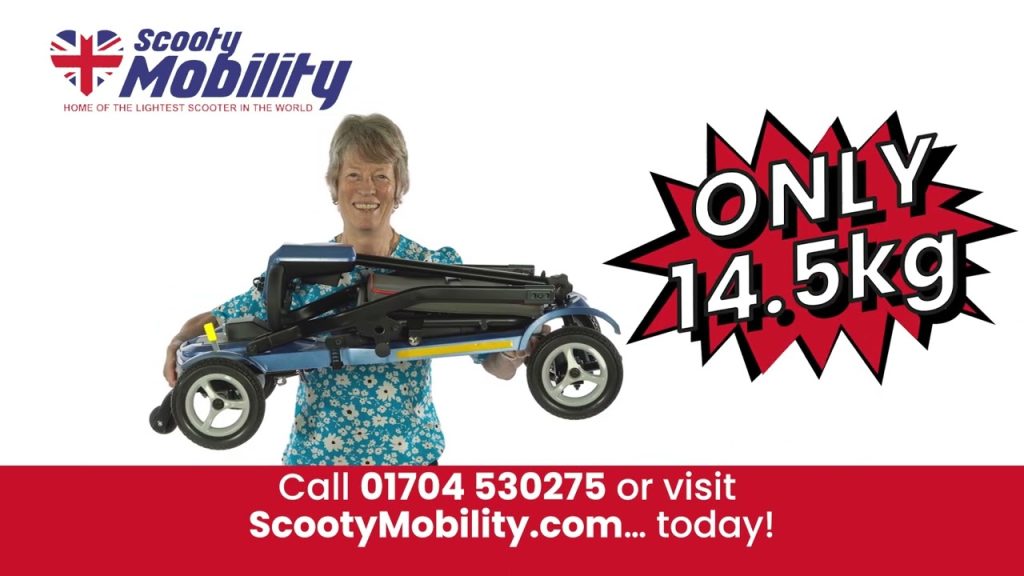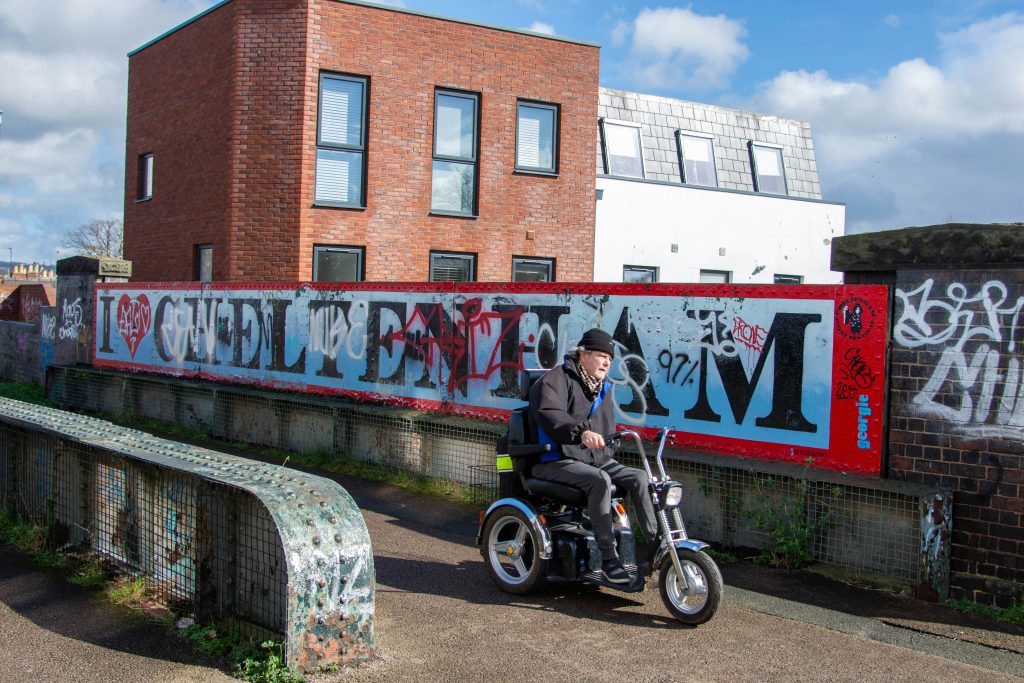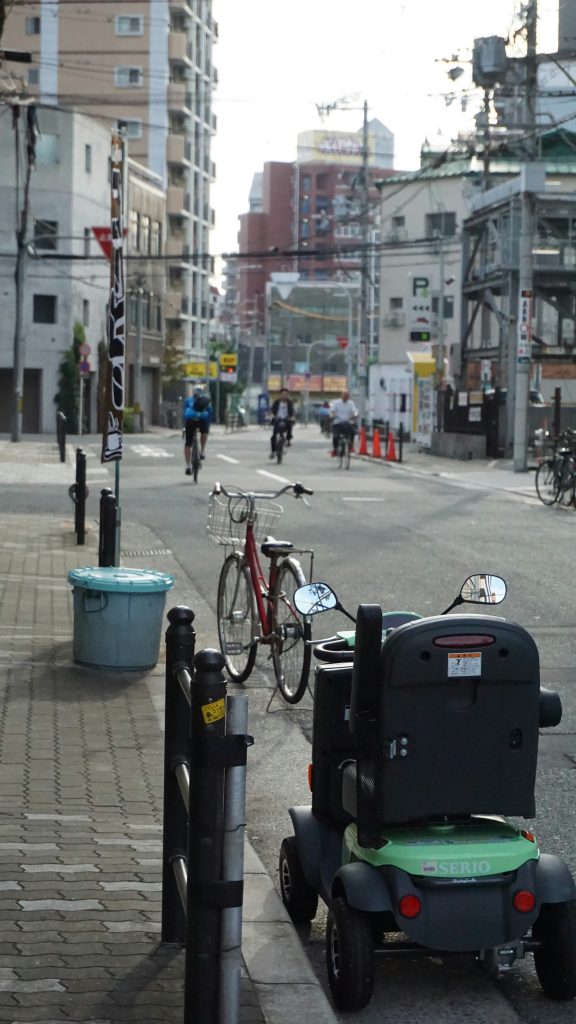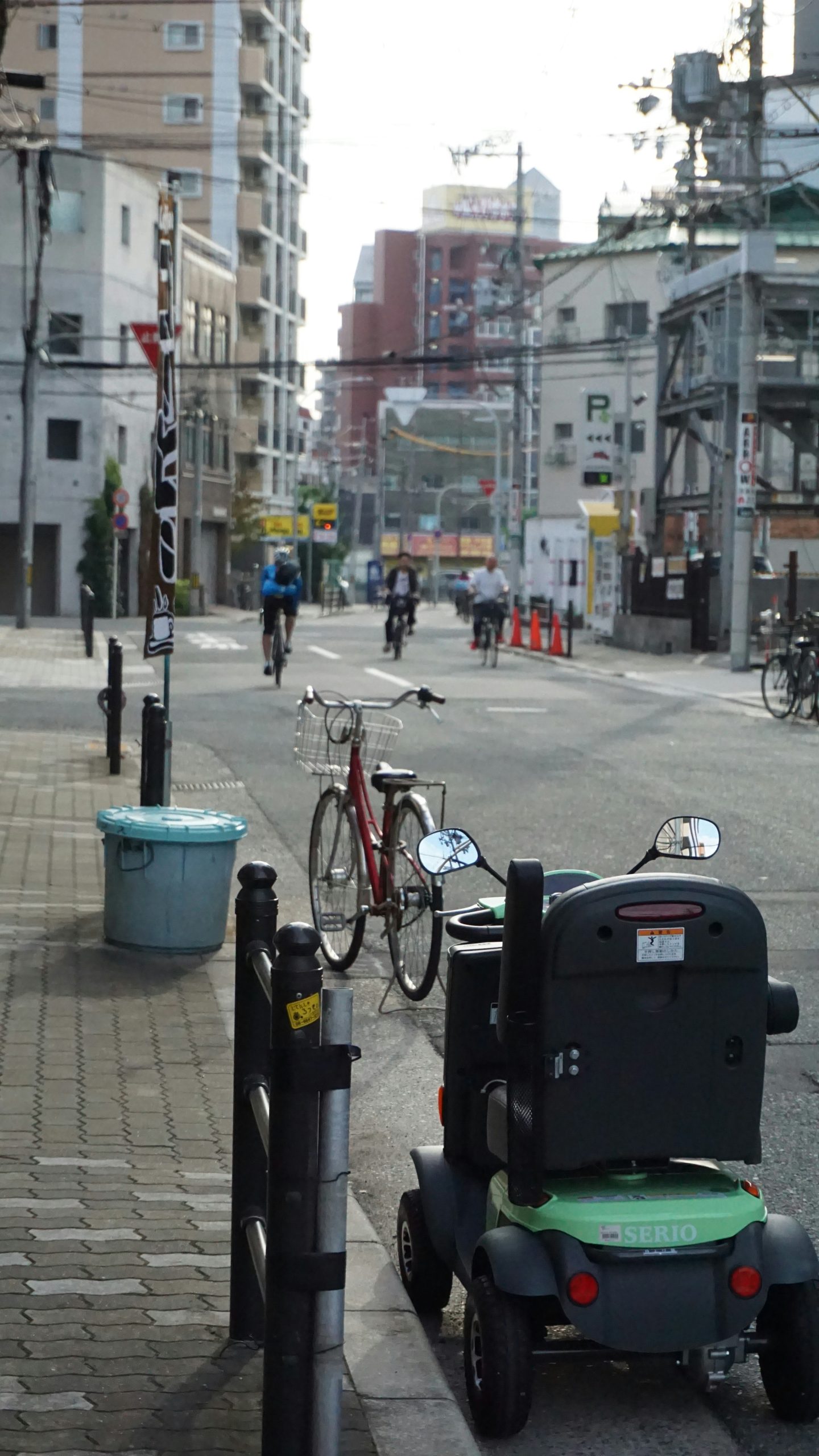Meet the Scooty Lite Lightest Folding Mobility Scooter, a four-wheel lightweight model that tips the scales at just 14.5 kg and folds away in seconds. It features an airline-friendly lithium battery for holidays by plane or cruise, supports users up to 125 kg, and uses a strong magnesium frame with 8-inch puncture-proof tyres for generous ground clearance.
A video by Scooty Mobility demonstrates the simple unfold-and-go setup, and the article outlines specs, travel compatibility, charging and battery rules, build quality, and practical handling tips. You’ll get clear guidance so you can decide if this compact, travel-ready scooter fits your lifestyle.
Scooty Lite Lightest Folding Mobility Scooter overview
Model identity and key promise
You’re looking at the Scooty Lite, a purpose‑built, ultra‑light folding mobility scooter that promises easy travel and everyday independence. The key promise is simple: a full‑function four‑wheel scooter that weighs only 14.5 kg, folds in seconds without dismantling, and is engineered for hassle‑free travel whether you’re catching a flight, boarding a cruise or navigating daily life.
Four wheel configuration and intended use cases
The Scooty Lite uses a four‑wheel layout to prioritize stability and confidence on paved surfaces. That configuration makes it well suited to sidewalks, shopping centres, airports, cruise terminals and light outdoor paths where you want more steadiness than a three‑wheel design typically offers. It’s intended mainly for short‑to‑medium distance trips, travel use, and day‑to‑day mobility rather than heavy off‑road or rugged terrain use.
Target users and ideal scenarios
You’ll find the Scooty Lite ideal if you travel frequently, want the lightest portable option available, or need a scooter you can lift into a car boot or onto a cruise ship without dismantling. It’s a good fit for active older adults, travellers with mobility needs, caregivers who transport a scooter regularly, and anyone who values portability alongside reasonable load capacity.
Video source and manufacturer attribution
This model and its promotional video are provided by Scooty Mobility (Video by Scooty Mobility). The scooter described here is marketed by Scooty Mobility and carries their branding and claimed specifications. You should refer to the manufacturer for official specifications, warranty details and the most current travel guidance.
Key features at a glance
Ultra lightweight chassis weighing 14.5 kg
At about 14.5 kg, the Scooty Lite is among the lightest folding mobility scooters available, which directly reduces the effort required to lift, carry or stow it. That low mass is the headline feature for travellers and people who need a scooter they can manage solo.
Airline‑friendly lithium battery for travel
The scooter includes an airline‑friendly lithium battery, enabling you to travel by air or cruise more easily than with larger lead‑acid batteries. This typically means the battery meets watt‑hour and safety limits set by airlines, but you should always confirm with the carrier in advance and carry any required documentation.
Maximum user weight capacity up to 125 kg
Scooty Lite supports users up to approximately 125 kg, which covers a broad range of riders. That capacity balances the light chassis with structural strength to handle everyday use without compromising portability.
Strong magnesium frame construction
A magnesium frame combines high strength with low weight. Using magnesium as the primary structural material helps keep overall mass down while providing a solid, durable chassis that resists bending and flexing under load.
Eight inch puncture‑proof tyres and increased ground clearance
With 8‑inch puncture‑proof tyres the scooter aims to minimise downtime from flats and reduces maintenance. The increased ground clearance compared with ultra‑compact scooters gives better ability to clear kerbs and small obstacles while still remaining a city/tourist‑oriented machine.
Folds in seconds without dismantling
One of the most practical features is the ability to fold or unfold quickly without removing the seat, battery or other parts. That saves time and effort at airports, stations or when entering vehicles and simplifies transitions for solo travellers.
Premium build quality and finish
Scooty positions the Lite as a premium product with attention to finish, fit and component selection. Expect tidy welds, corrosion‑resistant coatings and a refined appearance intended to deliver both durability and good looks.

Design and build quality
Magnesium frame benefits: strength and lightness
Using a magnesium frame delivers an excellent strength‑to‑weight ratio. You benefit from a chassis that resists fatigue and remains stiff during turns, while the lighter frame reduces lifting strain when you stow or carry the scooter. Magnesium also dissipates heat well, which can help with motor mounting and longevity.
Chassis layout and weight distribution for stability
The chassis is designed so the battery and motor are close to the centre of gravity, improving stability and reducing the chance of tipping when turning or on slight inclines. With a four‑wheel base and a relatively low centre of gravity, you’ll experience more stable cornering and steadier handling than many ultra‑narrow designs.
Tiller and controls layout and adjustability
The tiller typically offers intuitive controls: speed dial, on/off switch, indicator for battery level, and thumb or twist‑throttle. Look for an adjustable tiller angle and height so you can set reach and line of sight that feel natural for your posture and arm length. Easy‑to‑operate controls matter for fatigue‑free use.
Seat design, cushioning and armrest options
Seat comfort is important for longer outings. Expect a basic padded seat with modest cushioning and a flat swivel mechanism for easy on/off. Some versions may offer adjustable or foldable armrests to help when transferring. Check seat width and depth to make sure it suits your body size and provides adequate support.
Surface finishes, colours and corrosion resistance considerations
Premium finishes and powder‑coated or anodised surfaces resist scratches and corrosion from road salts or coastal environments. Colour options may be limited, but the quality of the finish influences long‑term appearance and resale value. You should confirm the paint or coating specifications if you plan to use the scooter near the sea or in harsh conditions.
Folding mechanism and portability
How the fold works: steps to fold and unfold
Folding is typically a straightforward sequence you can perform in seconds. A common approach is: 1) power off the scooter; 2) fold down or unlock the seat if required; 3) release a latch on the tiller or base; 4) collapse the tiller toward the rear and fold the chassis so the wheels nest neatly; 5) secure any catch that locks the scooter in the folded position. To unfold, reverse the steps: release the catch, extend the chassis until it locks, raise the tiller and seat, and check the latch engages before powering on.
No dismantling required: advantages for quick travel
Because you don’t need to remove the seat, unbolt the battery or disassemble parts, you’ll save time and avoid needing tools. That convenience is especially valuable at airports, on cruise ships or when transferring the scooter into a vehicle, reducing the physical strain and complexity of travel.
Folded dimensions and storage footprint (what to measure)
When assessing storage needs, measure the folded length, width and height and the footprint when standing on end. Also check folded depth including protruding wheels or tiller ends. Confirm the folded height fits your car boot, trunk or cabin storage space and whether the scooter can stand upright unaided or needs a bag/trolley to lean against.
Carrying options: built‑in handles, carry bag or trolley
See whether the scooter has built‑in carry handles or a dedicated grab point for lifting. Some owners use a padded carry bag or dedicated travel trolley to protect the scooter and make wheeling it like luggage easier. If you’ll shoulder the scooter, consider carrying straps or a trolley system to reduce strain.
Lift weight and tips for a single person to handle
At 14.5 kg the scooter is manageable for many people, but safe lifting technique still matters. Bend your knees, keep the scooter close to your body, and lift with your legs—not your back. If the scooter must be lifted into a car, use the edge of the boot as a step to reduce the lift height, or slide the scooter on a small ramp if available. Consider a lightweight folding ramp to make single‑person loading easier.

Battery technology and charging
Airline friendly lithium battery: implications and limits
Airline‑friendly typically means the battery falls within permitted watt‑hour (Wh) limits or has approvals to be carried in cabin or as checked luggage under specific conditions. Many airlines allow mobility device batteries up to 100 Wh without special approval and may permit larger batteries up to 160 Wh with airline consent. Rules vary widely, so check the carrier’s policy and provide battery documentation when requested.
Removable versus fixed battery considerations
A removable battery simplifies security checks and makes charging easier away from the scooter, while a fixed battery avoids the need to manage separate modules. If you travel frequently, removable batteries allow you to carry the battery in cabin while the scooter travels separately; however, you must follow airline restrictions for battery carriage.
Typical charging time and charger type to check
Typical charging times for scooter batteries range from 4 to 8 hours depending on capacity and charger output. Check the charger’s voltage and ampere rating—an onboard charger with 2A will charge slower than a 4–5A external charger. Confirm the charger plug type and whether a travel adapter is needed.
Battery range factors and how to maximize runtime
Range depends on rider weight, terrain, average speed, stop‑start travel, and ambient temperature. To maximise runtime: keep tyre pressure at recommended levels, avoid full throttle when unnecessary, reduce luggage weight, and use a moderate speed. Cooler temperatures reduce battery efficiency, so plan conservatively in cold weather.
Battery safety, labeling and airline documentation tips
Ensure the battery pack is labelled with watt‑hour rating, manufacturer details and safety markings. Carry the battery’s data sheet or manufacturer documentation showing Wh rating and any approvals. If required by the airline, present the documentation at check‑in. Always transport batteries in a protected state of charge per airline guidance and ensure terminals are insulated against short circuits.
Performance and practical range
Factors affecting real world range: terrain, rider weight and speed
Your real‑world range will be less than the manufacturer’s ideal figure. Uphill gradients, rough surfaces, heavier rider plus luggage, and frequent starts and stops all reduce range. Smooth pavement, moderate cruising speed and a lighter load will give you the best distance per charge.
Top speed expectations and use‑case suitability
Compact folding scooters typically reach top speeds in the 6–8 mph (10–13 km/h) range. That speed is suitable for sidewalks, pedestrian zones and airport terminals, but it’s not intended for busy roads or fast cycleways. If you need higher speeds for longer commutes, compare models with more powerful motors.
Acceleration, hill climbing and ground clearance relevance
Acceleration and hill‑climbing depend on motor power, battery output and weight distribution. The Scooty Lite’s increased ground clearance and decent wheel diameter improve its ability to clear small curbs and handle slightly uneven terrain, but steep hills will still reduce speed and range. Check the manufacturer’s rated maximum incline to match the routes you’ll use regularly.
Tire performance on different surfaces and puncture‑proof benefits
Puncture‑proof tyres remove the worry of flats and reduce maintenance, delivering reliable performance on tarmac, concrete and compacted paths. They usually offer less shock absorption than pneumatic tyres, so you’ll feel more vibration on rough surfaces. For mixed terrain, consider suspension or additional padding in the seat.
Load capacity impact on performance
Operating near the 125 kg maximum will lower acceleration, reduce top speed on inclines and shorten range. If you regularly carry shopping or luggage, account for that extra weight in your range planning and when selecting accessories.

Comfort, ergonomics and user experience
Seat comfort, height and swivel options to look for
Look for a seat with sufficient width, supportive cushioning and a swivel feature that rotates to help transfers. Adjustable seat height improves comfort and ensures your feet sit flat on the footwell, which helps posture and control. If you expect long outings, test the cushioning for firmness and breathability.
Tiller angle and handle grips for comfort and control
An adjustable tiller angle helps you set a natural wrist and shoulder position, reducing fatigue. Ergonomic handle grips with a textured surface make control easier and reduce hand strain over longer trips. Check that the throttle and brake controls fall naturally under your fingers.
Footwell space and ride posture considerations
A roomy footwell helps you keep a comfortable posture and maintain balance. Your knees should have slight bend, with hips supported by the seat and feet resting securely. If you have limited leg movement, confirm that the scooter’s footwell depth and seat height allow for safe, comfortable positioning.
Noise and vibration levels during operation
Because the scooter is electric and uses compact tyres, operation is normally quiet. You may notice motor whine under load and more vibration on rough surfaces due to puncture‑proof tyres. If you’re sensitive to vibration, try a test ride over variable surfaces to judge comfort.
Storage options: baskets, underseat space and accessories
Check what accessory options are available: front or rear baskets, underseat storage, cup holders and phone mounts. Accessories make daily life easier but add weight, so factor them into your carrying and range calculations.
Safety features and compliance
Brake systems and expected braking behavior to verify
Confirm the type of braking system—electric regenerative braking, electromagnetic or mechanical drum/disc brakes—and make sure braking holds the scooter reliably on inclines and stops smoothly from your typical cruising speed. Test braking responsiveness at low speed before venturing into busy areas.
Stability features including four wheel layout and anti‑tip design
The four‑wheel base gives inherent stability, and many scooters include anti‑tip wheels or a wide wheelbase to prevent backward and lateral tipping. Verify how the scooter reacts when turning at speed and when negotiating small kerbs to ensure you feel secure.
Lights, reflectors, horn and visibility features for public use
For public spaces and travel hubs you’ll want adequate front and rear lights, reflectors and a horn or bell for audible warning. These features improve safety in low light and crowded environments and are often required by local regulations for public use.
Certifications and standards to confirm (safety and battery)
Ask for applicable certifications, such as CE marking for European markets, UN 38.3 battery testing for lithium cells, and any local mobility device approvals. These confirm the scooter meets recognised safety and battery transport standards.
Recommended pre‑ride safety checks
Before each ride check tyre condition, battery charge level, seat security, brakes, lights and tiller lock. Ensure any folding latches are fully engaged and test a short run in a safe area to confirm normal operation before setting off.

Maintenance and care
Routine maintenance checklist and frequency
Perform weekly visual checks of tyres, frame and controls. Monthly, inspect battery connectors, tighten visible fasteners, test brakes and ensure lights function. Arrange annual professional servicing for electrical checks, motor inspection and deeper mechanical maintenance.
Battery care best practices and storage guidance
Store the battery at around 40–60% charge in a cool, dry place for long‑term storage. Avoid leaving the battery discharged for long periods. Charge before extended storage and top up periodically. Keep battery terminals clean and protect against moisture.
Cleaning tips for frame, seat and electronic parts
Wipe the frame with a soft damp cloth and mild detergent; avoid high‑pressure water around electronics. Clean the seat with fabric or vinyl cleaner as appropriate. Dry thoroughly after cleaning and check for any exposed wiring or corrosion.
Troubleshooting common minor faults and when to seek service
Common minor faults include poor range (check tyre pressure, charge cycles), flat controls (check fuse and battery connection), and intermittent power (inspect charger, battery and connections). If you encounter unusual noises from the motor, persistent error codes, or failed brakes, seek professional service rather than attempting complex repairs yourself.
Servicing, spare parts availability and DIY limits
Confirm with the manufacturer or dealer the availability of spare parts such as chargers, batteries, seats and wheels. Basic maintenance like tyre cleaning, battery charging and tightening bolts you can do yourself; anything involving the motor, controller or structural repairs should be handled by authorised service centres to preserve warranty and safety.
Conclusion
Suitability summary: who benefits most from Scooty Lite
The Scooty Lite is best for travellers and active individuals who need a genuinely portable, airline‑friendly mobility scooter. You’ll benefit most if you want a four‑wheel stable platform that’s lightweight enough to carry and stow easily, and you frequently travel by car, plane or cruise ship.
Key pros and potential trade‑offs to consider before buying
Pros: exceptionally low weight (14.5 kg), fast folding without dismantling, airline‑friendly battery, puncture‑proof tyres and a strong magnesium frame. Trade‑offs: smaller 8‑inch tyres mean firmer ride on rough surfaces, limited top speed and range compared with full‑size scooters, and potential seat or accessory limitations for very long outings.
Practical next steps: test ride, verify travel rules and confirm warranty
Before buying, arrange a test ride to check comfort, handling and folding in real conditions. Verify airline and cruise line rules for lithium batteries and mobility devices, and confirm warranty terms, spare part availability and local service support.
Final recommendation and call to action for prospective buyers
If portability and travel convenience are your highest priorities and you need a stable four‑wheel platform for daily outings and trips, the Scooty Lite is a compelling option. Try one in person, check the battery paperwork for your travel routes, and compare dealer support and warranty so you can buy with confidence and start enjoying easier travel and independent mobility.
The amazing new four wheel lightweight folding mobility scooter available from @scootymobility7927 which weighs only a world beating 14.5 kg and folds away in seconds. Scooty Lite has a airline friendly lithium battery allowing you to take Scooty Lite on your holiday, weather that be on an Airline or Cruise ship. Scooty has a maximum user weight of up to 125 kg made from a strong magnesium frame, lots of ground clearance with its 8 Inch puncture proof tyres premium build quality. It folds without the need to dismantle anything just unfold it within seconds and away you go.



